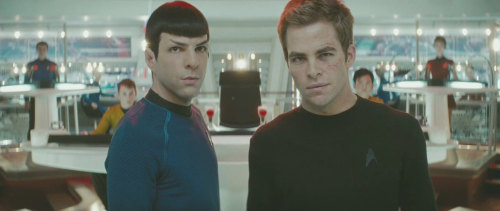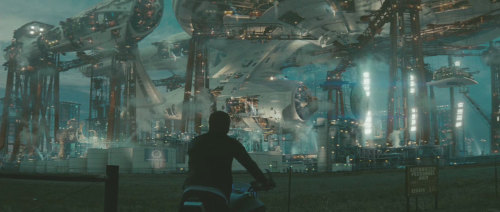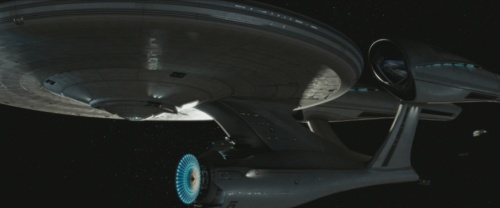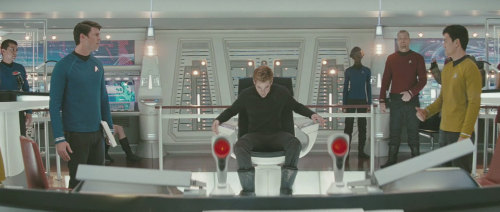Star Trek (J.J. Abrams, 2009)
I’ve said this before: the seeds of the problems with the Star Trek movie franchise were planted right at the start.
When they made Star Trek: The Motion Picture back in 1979 they tried to make an epic. They got an A-list director in Robert Wise (keep in mind that just a few years earlier his Sound of Music had been the highest grossing film ever) and treated it as a prestige production along the lines of 2001: A Space Odyssey. But Trek has always been a bit silly, and taking it too seriously killed the fun. So for Star Trek II: The Wrath of Kahn – still widely considered the best film of the series – they went back to lower budgets and lesser ambitions. It worked, and Trek was fun for a long time, but it was never again particularly adventurous or grand or spectacular. Ultimately, the film and television Trek experiences blurred together, until there was simply no reason for either fans or the more casual observer to go to the cinema and see a Trek film. So when I reviewed the last Trek film, Nemesis, I suggested that Paramount needed to cut off the supply of Trek for a while, let some demand build, and then come back with something big.
Well we’ve had the seven year break, and now J.J. Abrams’ shiny new 2009 Star Trek is the attempt to wow us. Abrams, who created the TV shows Alias and Lost, is carving himself a reputation as a franchise resuscitator, having performed similar duties with Mission Impossible III. His style is a product of TV’s 42 minute episodes and emphasises speed, boldly drawn characters, and ceaseless narrative progression. Such a no-nonsense style suggests that certain heights of achievement will remain beyond him: I don’t think he could make a truly great genre film like a Star Wars, Aliens or The Fellowship of the Ring. But he knows how to craft efficient entertainment, and Star Trek shows him to be a good fit for the franchise. In a series that had forgotten how to be crowd-pleasing and had moved to niche-pleasing (at best), he is just what was needed. This 2009 Star Trek is big, exciting, funny, and should act as a solid launchpad for a new series of Trek films.
Abrams has come up with an ingenious conceit to lure back both the jaded fanbase and the more general public. The film centres on the first mission of the original crew: Kirk, Spock, Bones, and the rest. Yet it’s not a straight flashback to the continuity of the existing series. Instead the film sees the elderly Spock (an extended cameo from Leonard Nimoy) and the villainous Nero (Eric Bana) travel back in time to when the original series’ characters (including Spock himself) were young. Before the opening credits have even rolled, the timeline has been altered, meaning that we can follow the adventures of the young versions of the characters without knowing how everything turns out. The real beauty of this, though, is that it opens the film up to both fans and non-fans. Fans can enjoy seeing the first meetings of Kirk, Spock, and the rest, and various subtle references to other adventures (we see, for example, an event from Kirk’s life that had been discussed in Star Trek II). Yet because the film creates its own alternative continuity, non-fans can see this as the beginning. It’s closely comparable to what the revived Doctor Who did: like that show, Abrams’ Star Trek is technically consistent with what came before, while also marking a decisively new start that can allow newcomers to climb on board. Abrams recognises that the sheer weight of all those movies and TV shows had made approaching the franchise almost a chore, and neatly rules a line under it all, rendering it irrelevant. Importantly, unlike many other recent reboots (such as the new Bond and Batman films), the new Star Trek doesn’t try to be darker or grittier. It just wants to be better.
The real challenge will be for the marketing boffins to get the message out that this is a film normal people – for want of a better term for the great mass of non Trek fans – can go and see. If those audiences do come along, they will be rewarded. Abrams has been given a bigger budget than Trek has enjoyed for a long time (in real terms, I would imagine this must be the biggest budgeted since Star Trek: the Motion Picture) and has used it to give some scale and sweep to the adventure. It’s exciting. It’s knocked a little off course halfway by one massive, annoying plothole – a coincidence too colossal to be excusable – but generally it races along fast enough that most audiences probably won’t quibble. The special effects are impressive and are used to realise some truly cataclysmic events. At the same time, there are actually some funny jokes, which is a considerable relief in a series that has previously considered comic relief to be a “Row Row Row Your Boat” singalong. The production design is particularly attractive, taking cues from the 1960s look of the original series but emphasising vivid colours and bright interiors for the Starfleet ships: it is at once retro and yet gleamingly modern, which is just what was required. (Somewhat less successful is the lumpy and graceless redesign of the Enterprise, which isn’t as elegant as either Matt Jefferies’ classic design for the original show or the sleek version created for the early movies).
The biggest challenge of Abrams’ approach was always going to be recasting iconic roles, but the performances turn out to be a key strength. As Kirk, Christopher Pine has the hardest job, simply because William Shatner’s acting style is so eccentric: Pine captures the swagger while mostly avoiding Shatner’s weird vocal mannerisms. Zachary Quinto is perhaps less of a revelation as Spock, as we have seen various other actors (notably Tim Russ in the TV show Voyager) do takes on Leonard Nimoy’s performance. Nevertheless, he ably grounds the film: Spock’s arc in this film is rather more central, and certainly more interesting, than Kirk’s familiar “troubled rebel makes good” story. The real revelation, though, is Karl Urban’s turn as McCoy. Urban absolutely nails a younger version of DeForest Kelley’s characterisation, while at the same time carving his own take on the character and proving adept at McCoy’s dramatic and comic functions. The original Star Trek was built largely around the central trio of Kirk, Spock, and McCoy, and in that respect Abrams’ revived series – assuming that is what now eventuates – looks to have a solid foundation.
The minor crewmembers are also effectively revived: Simon Pegg gives a version of Scotty that doesn’t have much to do with James Doohan’s but which is nevertheless entertaining; John Cho pays tribute to George Takei’s physicality as Sulu; Zoe Saldana recognises that the 60s show used Uhura for sex appeal, but finds a more modern strength for the character; and Anton Yelchin does all you can do with the role of Chekov – milk the funny accent for all it’s worth. In the middle of this, it’s a little disappointing that Leonard Nimoy walks through the role of Spock, relying on his iconic stature and beautiful speaking voice but not really doing anything identifiably Spock-ish: it really is as if he is just playing the narrator from Civilization IV.
Ultimately, what Abrams achieves here is very close to what the Bond producers did with Casino Royale. Like that film, taken on its own this is a good but not brilliant film. What it does extremely well, though, is make you want to see the next instalment. The foundations have been laid for a worthwhile rebuild of Trek.



